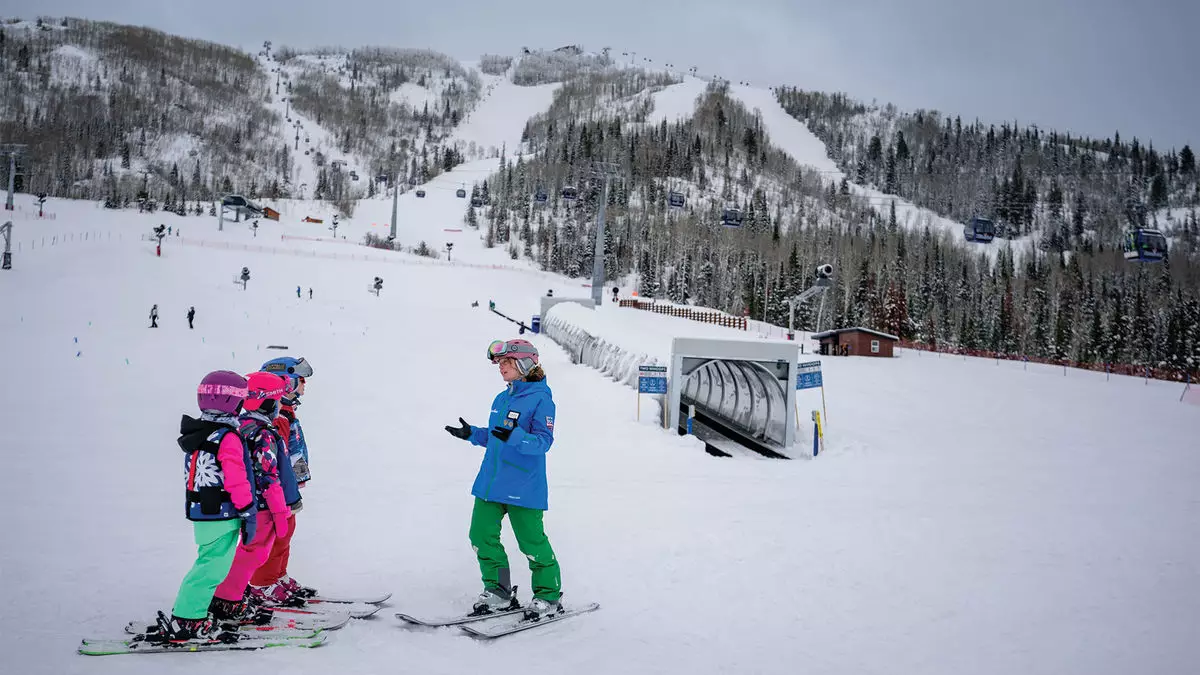When it comes to skiing and snowboarding, where lessons are conducted can significantly influence the learning experience. Many ski resorts are increasingly recognizing that beginning lessons high up in the mountains—not at the base—affords students a far more immersive and memorable initiation into the sport. Rather than absorbing the anxieties that come with tangled traffic on the busy base slopes, novices enjoy a less congested, breathtaking environment. It’s this majestic backdrop of rugged mountains that fuels their passion for skiing from the very first lesson. “Even if it’s your first time, it gives you that full mountain experience,” emphasizes Emily McDonald from Park City Mountain Resort. What better way to create a connection with the sport than to start high above, surrounded by crisp, invigorating mountain air?
As students embark on their inaugural skiing journey atop the hills, they aren’t merely learning to navigate the snow; they are also savoring the thrill of being where the action is. The concepts of leisure and adventure become intertwined, setting the stage for what can evolve into a lifelong passion. The shift from base to mountain initiates a unique, transformative environment for first-time skiers, instilling a sense of belonging and excitement that can often be absent in more conventional, crowded settings.
Innovative Learning Environments at High Elevations
Ski resorts like Park City have advanced by establishing dedicated learning areas at higher elevations. The High Meadow learning region, opened in 2018, is a prime example, offering a specially-designed beginner zone complete with carpet lifts and easy access to slopes tailored for new skiers. The strategic decision to place the lesson center at over 1,000 vertical feet above the base ensures that students are not only free from the hustle and bustle of advanced skiers, but also sheltered within a carefully curated environment specifically designed to enhance their learning. This structure has proven especially beneficial for parents too, enabling them to quickly check in on their little ones whilst indulging in their own skiing adventures.
Jackson Hole Mountain Resort took a similar approach with their Solitude Station learning area, where the elevation enhancement has not only increased satisfaction rates but also transformed the way lessons are delivered. Implementing terrain-based instruction, where the landscape is crafted to facilitate natural turning motions, offers an appealing strategy for introducing new skiers to the slopes. The elevation jump of merely 238 vertical feet has had a cascading positive effect on both the learning experience and repeat visitation—outcomes that cannot be easily dismissed.
The Power of Gondolas: Redefining Access
A crucial element of this relocation trend to midmountain learning centers is the use of gondolas. Unlike traditional chairlifts that require some initial skiing knowledge for boarding, gondolas allow newcomers to maintain their skis off for the journey up the mountain. This ease not only caters to beginners but also encourages family members who don’t ski to accompany their novice, further reinforcing the sense of camaraderie. There’s something undeniably exhilarating about riding a gondola high above the ground—new skiers gain an expansive view of the slopes, thereby stimulating their curiosity and anticipation for the adventures that lie ahead.
Resorts like Steamboat have embraced this innovative gondola setup with the development of their Greenhorn Ranch. This facility enriches the learning experience by providing a dedicated environment suitable for direct beginner instruction, freeing up space at the base to enhance other offerings. With features designed to foster safety and learning, like the first 自动 safety bar chairlift in the U.S., Greenhorn Ranch exemplifies how thoughtful design can translate into impressive results—guest satisfaction has reportedly surged by more than 200%.
A Harmonious Learning Atmosphere Above the Crowds
Learning how to ski or snowboard can undoubtedly be a daunting experience for first-timers, especially when surrounded by more experienced skiers. The steady stream of confident riders flying past often serves as a discouraging reminder of what they have yet to master. This is where the elevation advantage demonstrates its value—by having beginner areas located high up the mountain, these novice skiers can learn without the omnipresent anxiety of more skilled guests nearby.
By providing designated spaces that feel secure, beginner skiers can flourish without the intimidation that often comes with starting a new sport. As Hanna Albertson points out, this simply by virtue of the setting, “it can be intimidating to be around all the other guests who are more advanced.” Elevating the teaching experience to the top of the mountain not only empowers the learners but also nourishes their spirits. The essence of skiing and snowboarding transforms into a shareable, enjoyable journey that bridges families, fosters friendships, and captures the very heart of these exhilarating winter sports.


Leave a Reply